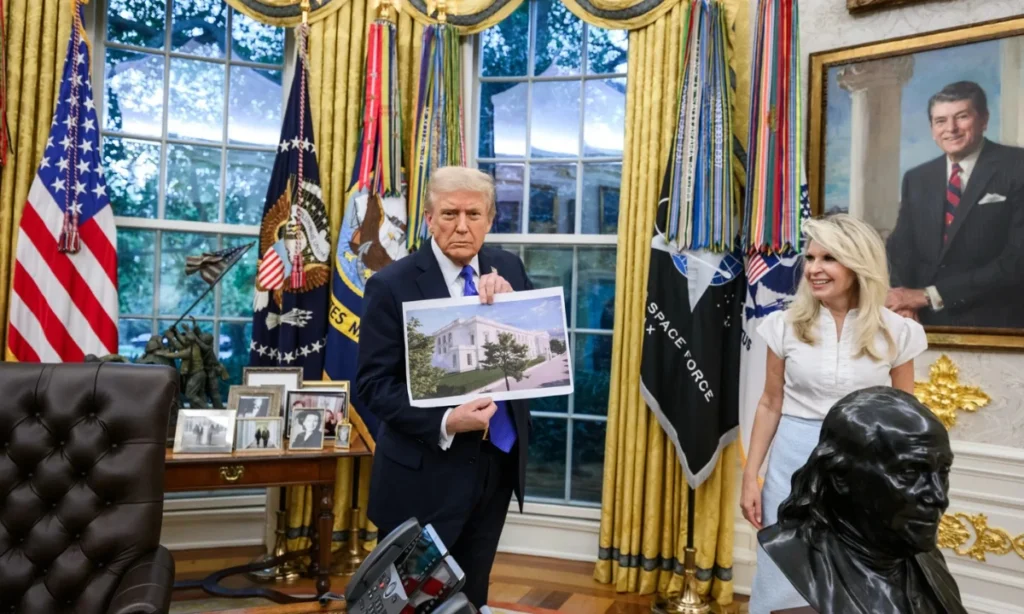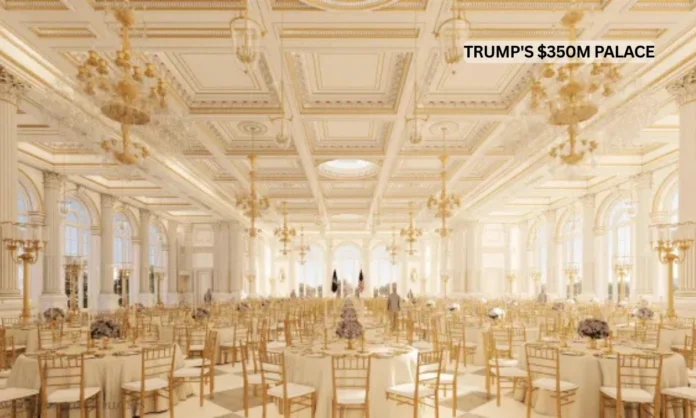Key Highlights:
- President Trump unveiled plans for a $300 million privately-funded ballroom, claiming to have already raised $350 million from donors and personal contributions
- The 90,000-square-foot addition will replace the East Wing and accommodate 999 guests, nearly double the size of the main White House
- Demolition proceeded without National Capital Planning Commission approval, exposing regulatory gaps in federal construction oversight
President Donald Trump’s ambitious 350 million White House ballroom project has sparked intense scrutiny over private funding sources and federal construction protocols. The commander-in-chief unveiled a scale model in the Oval Office this week, describing plans for what he calls the “most beautiful ballroom anywhere in the world”. Trump’s 350 million White House ballroom initiative represents the largest addition to the presidential residence since the 1940s Truman renovation, with the project already exceeding its original $200 million estimate. The private funding model for Trump’s 350 million White House ballroom has drawn criticism from ethics experts who question potential conflicts of interest with corporate donors.

Project Scope and Financial Details
Trump’s 350 million White House ballroom will span 90,000 square feet, nearly double the size of the main White House structure. The president confirmed that private donors have contributed approximately $350 million, surpassing the project’s estimated $300 million cost.
- The ballroom will accommodate 999 seated guests, a significant increase from the East Room’s 200-person capacity
- Construction involves complete demolition of the existing East Wing, built in 1902 and renovated multiple times
Trump’s 350 million White House ballroom funding sources include major corporations such as Amazon, Google, Meta, Microsoft, Apple, and Lockheed Martin. The president indicated he would personally contribute “millions of dollars” to the project, though specific amounts remain undisclosed. One anonymous donor reportedly wrote a $130 million check to cover potential cost overruns, with Trump calling this contributor “a patriot”. YouTube, a Google subsidiary, provided $22 million as part of a settlement from Trump’s 2021 lawsuit against the company.
Regulatory Oversight and Legal Framework
The Trump administration proceeded with East Wing demolition without submitting construction plans to the National Capital Planning Commission, the federal agency responsible for reviewing White House projects. White House Staff Secretary Will Scharf, who chairs the NCPC, defended this approach by distinguishing between demolition and vertical construction requirements.
- The National Capital Planning Commission typically oversees federal construction projects through a three-phase approval process
- The White House argues that demolition falls outside NCPC jurisdiction, focusing only on new construction phases
Former NCPC chairman L. Preston Bryant disputed this interpretation, stating that “demolition is not separated from construction” and should be part of the overall project review. Trump’s 350 million White House ballroom project benefits from exemptions under the National Historic Preservation Act of 1966, which excludes the White House, Capitol, and Supreme Court from standard historic preservation reviews. The National Trust for Historic Preservation submitted formal objections to the project, calling for a halt to demolition pending proper review processes.
Historical Context and Comparative Analysis
Trump’s 350 million White House ballroom represents the most expensive presidential residence modification in modern history. The most extensive previous renovation occurred during Harry Truman’s presidency from 1948-1952, costing $5.7 million (approximately $77 million in today’s dollars).
- The Truman renovation involved complete interior reconstruction while preserving exterior walls due to structural collapse risks
- Obama administration renovations focused on modernization and energy efficiency rather than major additions
- The original White House construction from 1792-1800 cost $232,000 (equivalent to $5.5-7.5 million today)
The Federal Reserve’s current headquarters renovation provides contemporary context for large-scale federal building projects. Initially estimated at $1.9 billion in 2021, Fed renovation costs have escalated to $2.5 billion due to historic preservation requirements, environmental hazards, and labor costs. Trump’s 350 million White House ballroom project, while substantial, remains significantly smaller than other federal renovation initiatives currently underway.
Corporate Donors and Ethics Concerns
The White House released a partial list of Trump’s 350 million White House ballroom donors, revealing contributions from technology giants, defense contractors, and wealthy individuals. Major contributors include Apple, Amazon, Comcast, Coinbase, and the Winklevoss cryptocurrency executives. The Adelson family, prominent Republican donors, also contributed to the project.
- Ethics experts describe the private funding model as creating potential conflicts of interest with government contractors
- The administration promises full transparency regarding donor identities and contribution amounts
- Some donors attended an exclusive East Room dinner to “Establish the Magnificent White House Ballroom”
Former White House chief ethics lawyer characterized the ballroom donations as an ethical “nightmare,” raising questions about donor influence on policy decisions. Trump’s 350 million White House ballroom funding model sets a precedent for privately financed federal infrastructure projects, potentially blurring lines between public service and private interests. The administration maintains that all contributions comply with federal ethics regulations and that donor disclosure will continue throughout the construction process.
Design Features and Construction Timeline
Trump’s 350 million White House ballroom will feature neoclassical architecture reminiscent of Mar-a-Lago, with sweeping staircases, chandeliers, and arched windows. McCrery Architects leads the design team, specializing in classical architectural styles, while Clark Construction heads the building phase and AECOM provides engineering services. The project began with East Wing demolition in October 2025 and aims for completion before the end of Trump’s current term.
- The ballroom design emphasizes ornate craftsmanship and classical elegance matching White House architectural heritage
- Construction will be “substantially separated” from the main White House building while maintaining thematic continuity
- Security enhancements and modifications will be provided by the United States Secret Service
Administration officials already refer to the space as “The President Donald J. Trump Ballroom,” though Trump has not publicly confirmed this naming decision. The president has described himself as “a builder at heart” and views the project as addressing a long-standing need for expanded entertaining space at the White House. Trump’s 350 million White House ballroom project reflects his broader effort to restore what he considers a neglected presidential residence, with the president claiming to have spent millions on previous White House improvements.
Final Perspective
Trump’s 350 million White House ballroom project represents an unprecedented blend of private philanthropy and presidential legacy building. While the administration emphasizes zero taxpayer cost and addresses genuine space limitations, the initiative raises fundamental questions about corporate influence, regulatory oversight, and the appropriate role of private funding in public institutions. The project’s success in navigating legal challenges and ethical scrutiny will likely influence future approaches to federal infrastructure development and presidential residence modifications.


